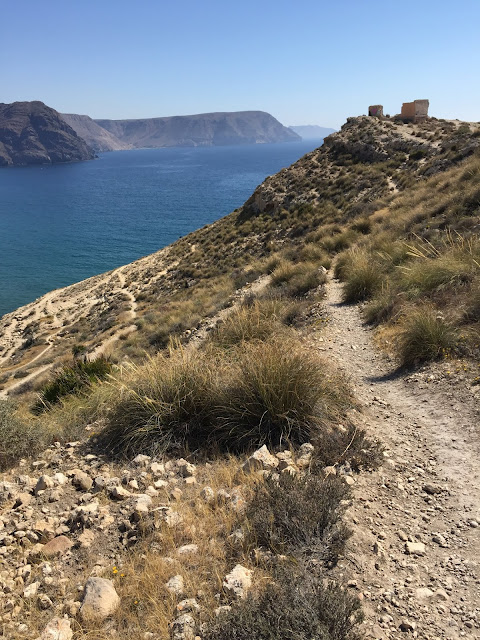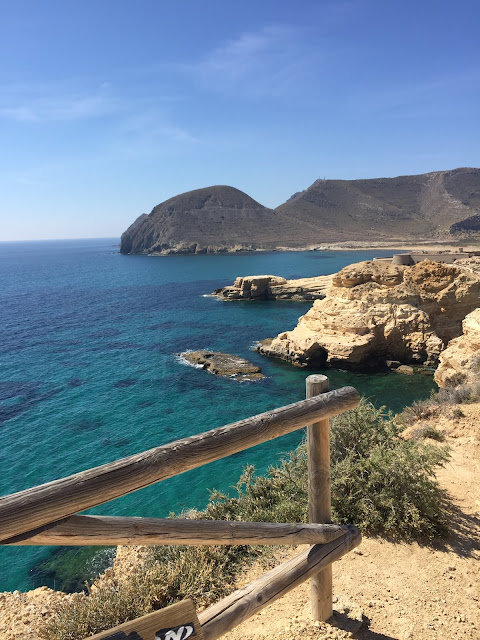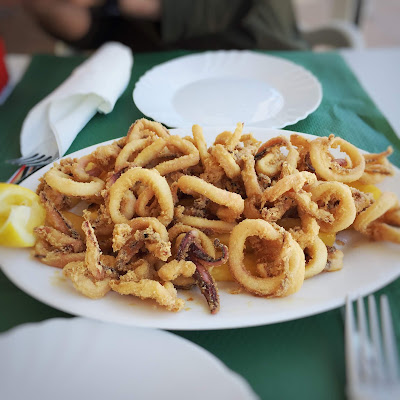Las Negras to Rodalquilar: Falling under the spell of the garden of dreams...
‘Hola! I’m here to collect your luggage!’
Very slightly hungover from too much cheap cava supped from the balcony the night before, Ricardo, the taxi driver who would be ferrying our luggage between accommodation, caught us somewhat by surprise. For someone who regularly rises at 5am, I was a little embarrassed to find we had slept until nearly nine. The Cabo de Gata was already working its magic in making us take life at a slower pace.
Lightened by losing the responsibility of our luggage, we headed downstairs for several cups of Paqui’s excellent café solo and a plateful of jamon and fruit. It felt a little sad to be leaving so soon, the Hotel Bitácora is certainly a place that is easy to relax in. After breakfast, Paqui handed us two large bags, our picnic for the day. Bulging with several bottles of water, a large bocadillo (sandwich) of more jamon and tomato, fruit and a couple of sweet cereal snack bars it was a struggle to squeeze this feast into our small day rucksacks (already rammed with Factor 50, swimming gear and camera equipment). Whilst wishing Paqui a fond farewell for a really lovely start to our trip I spied a familiar Inntravel folder on the table of the only other guests. We would chat regularly with these fellow walkers as they followed in our footsteps a day behind.
We set off in the opposite direction of Las Negras, crossing the road and taking a sandy bottomed dry river bed towards a campsite on the edge of a beach, stopping to take in the view of the distinctive black ‘face’ of Las Negras before turning steeply up along a rocky track into the next headland, the path disappearing and reappearing confusingly as we tried to keep an eye out for the blue and white flashes of paint marking our way. At the top of the headland the path became more obvious as it followed the edge of the cliff, sometimes scarily close to the edge. Summing up hidden courage to open my eyes and glance down the view was spectacular, azure sea sparkled against jagged white rocks hundreds of metres below.
As the path headed inland and onto a little less precarious journey, a sun bleached headland came into view, topped by by the 18th century ruins of the Fort of San Ramón, literally hanging over the sea. Built by Carlos III in 1764, to protect against attacks by Barbary pirates, just like the much older watchtower at San Pedro discovered the day before, it became obvious that this coast had been under attack for centuries. Just before we neared the fort, a noticeboard at the cliff edge provided some information on the ‘posidonia meadows’ a sub aquatic field visible from the cliff top, a reminder that both the land and sea form part of this important reserve.
Hot from our walk, the beach below San Ramón beckoned seductively but a closer inspection revealed that the sand was studded with medusa (jellyfish) stranded on the shoreline, the waters literally swarming with gently swaying stingers. We watched in fascination as this transparent purple tinged swarm washed in with each wave, a single brave snorkeler gingerly entering a toe into the infested waters before retreating quickly.
The walking notes instructed us to walk across the Playa Playazo and when reaching the end of the beach, turn inland past an impressive overhanging rock to an oasis of palm trees standing exotically tall within the low scrub. Here, slightly hidden from view where two restored norias (water wheels or ‘blood wheels’), an ancient animal driven mechanism for extracting water from wells deep below. Taking the harness in hand we pushed the wheels around and slowly, as the wooden structure squealed into life, the whisper of water could be heard from the shadowy depths, disturbing ghosts from the harsh life of the past. Ten minutes further along, another relic, the Torre de los Alumbres, a crumbling military tower, stood out amongst the clumps of agave in the scrubland bordering the beach. Built in 1510 to protect the Rodalquilar valley, it proved to be a little inadequate when just 10 years later the entire population of the village was captured and sold to slavery. It remained the only source of protection up to the 18th century, variously used as military barracks before being superceded by the Fort of San Ramón.
Passing the tumbledown tower at the edge of a dusty track, the route took us onwards through the Rodalquilar valley, an area not permanently settled until the late 18th century due to its disruptive history. We passed through the tiny hamlet of La Ermita, following the notes carefully to make sure we didn’t miss the turn into another dry river bed. Strewn with rocks and boulders the walking was difficult, full attention needed before placing each step. Several years before, this area was devastated by intense and unusual rainfall, leading to severe flash flooding and we came across the rusting wreck of a car, laying half submerged in the sand, a remnant of the chaos of these floods. Carefully we walked onwards, tiring a little at the uneven terrain, it was a relief to see the blue painted gate and windmill of our next accommodation, El Jardin de los Sueños, very accurately translated as the garden of dreams.
It's as though I'd drunk a bottle of anise and fallen asleep wrapped in a quilt of roses.
Federico García Lorca, Blood Wedding
Waking in the early evening, we decided to just relax in the gardens and ordered a bottle of rosé from Eckhard, the leftover sandwich and fruit from Paqui’s generous picnic providing a light late supper. As the only guests we sat on the circular terrace watching the sun set over the red-brown mountains, drinking in the peace and mystery of this ancient land. Eckhard joined us under the darkening skies, the three of us watching the stars unfold and sharing concerns about the uncertainties and madness of current politics before listening to Eckhard's journey to settling in this beautiful part of Spain.
His five cats arrived one by one as the sun finally slipped beneath the horizon, casting eery shadows in the candlelight, and Eckhard told us more about the tragedy at the Cortijo del Fraile, the destination of our walk the following day. It had only been our third day in the Cabo de Gata and already I was caught in the spell of this hauntingly beautiful and magical place.
*Leche frita - a traditional Spanish dessert, literally translated as 'fried milk'. It's actually a cold milk pudding that's covered in breadcrumbs and fried and is delicious with lots of whipped cream or ice cream and dusted with cinnamon. A good recipe is available from The Spruce Eats.
*Leche frita - a traditional Spanish dessert, literally translated as 'fried milk'. It's actually a cold milk pudding that's covered in breadcrumbs and fried and is delicious with lots of whipped cream or ice cream and dusted with cinnamon. A good recipe is available from The Spruce Eats.















Comments
Post a Comment